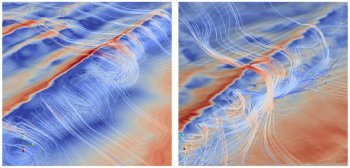
3D airflow model simulation of how wind behaves when traversing over sand dune topography onto beaches. Results show flow line differences in surface airstreams during directly offshore winds (Left image) and obliquely offshore (Right image) highlighting unusual corkscrew vorticity which induces complex patterns of wind-blown sand transport on beaches.
Scientists from the University of Ulster have received accolades from a leading US geoscience organisation for their most recent research findings.
The Natural Environment Research Council (NERC)-funded research on the physics of blown sand on beaches has been selected as the American Geophysical Union’s (AGU) spotlight article.
Spotlight articles are selected by the AGU as the best in the field in terms of their global importance.They are published online and feature in the AGU newsletter, EOS.
The research article, which was published in the Journal of Geophysical Research, examined complex wind flow patterns over beach and dune systems. A total of 10 international journal articles and 15 conference presentations have been generated from the NERC-funded research project led by Professor Derek Jackson since 2010.
Professor Jackson, who is Professor of Coastal Geomorphology and a member of the Environmental Sciences Research Institute said he is delighted at the continued international recognition of their research.
He explained that they used state-of-the-art equipment to measure and model wind as it moved over irregular dune surfaces onto the beach.
“This work has given us real insights into the complexity of fluid flow in natural environments and adds to our science-led approach in managing naturally dynamic systems like sandy coastlines,” said Professor Jackson.
The fieldwork for thethree year study was carried out at Magilligan Strand, Northern Ireland, where the presence of an MOD firing range provided safety for the equipment and allowed for the collection of wind and sand transport measurements at unparalleled resolution using an array of anemometers and sediment traps measuring at up to 50 times per second.
“Ultimately these results will help those who manage dune coastlines, giving further insights into dune build-up and erosion patterns,” added Professor Jackson.
Co-investigator, Professor Andrew Cooper said: “Our findings not only help us understand how dunes form on the beach, but also how they reform after storms. We were able to model these flows in a computer, but to be able to measure them needed the world class suite of field equipment that we have now amassed.”
As the premier international newspaper of the Earth and space sciences, the AGU’s Eos publication forge strong interdisciplinary ties among geophysicists and places important contributions of geophysics in the context of the social and policy-making arenas.

















